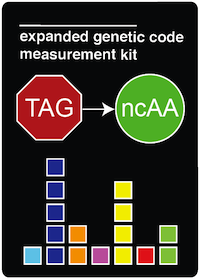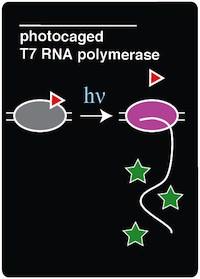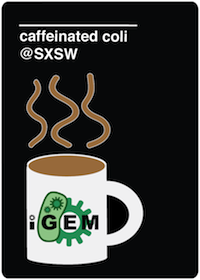Team:Austin Texas
From 2014.igem.org
| Line 82: | Line 82: | ||
| [[Image:Austin_Texas_Photocage_Card.png|link=Team:Austin_Texas/photocage]] | | [[Image:Austin_Texas_Photocage_Card.png|link=Team:Austin_Texas/photocage]] | ||
| <h1>Project: Photocaged T7 RNA Polymerase</h1> | | <h1>Project: Photocaged T7 RNA Polymerase</h1> | ||
| - | + | Noncanonical amino acids (ncAAs) may have unique chemical groups that can provide very useful functionality not normally present in an organism. This summer we used a photocaged ncAA, ortho-nitrobenzyl tyrosine (ONBY), to prevent protein functionality until spatially and/or temporally triggered by light. To this end, our team successfully recreated a light-activatable T7 RNA Polymerase (RNAP) for a method of noninvasive, spaciotemporal control of protein expression. We chose T7 RNAP because there is a tyrosine residue in the active site of the polymerase. By changing this codon to an amber codon, we were able to incorporate (ONBY), a photocaged tyrosine, into the active site. The presence of the extra ONB group inhibits T7 RNAP activity. When exposed to 365 nm light, the molecular cage (the ONB group) is released, leaving tyrosine. Thus, T7 RNAP is only functional when exposed to 365 light, which restores the native T7 polymerase active site that is necessary for proper function of the enzyme. To test this system, we used a GFP reporter with a T7 promoter. We were able to see a significant increase in GFP expression upon photodecaging T7 RNAP, as expected. In a separate experiment (with no T7 present), we attempted to photoactivate GFP with ONBY incorporated into the fluorophore. However, we could not detect appreciable GFP activity in this case. The success of T7 activation may be due to the amplifying effect of decaging a single molecule of T7 RNAP relative to decaging a single molecule of GFP. | |
|- valign="top" | |- valign="top" | ||
| [[file:caffeinecolisxsw.png|200px| link=https://2014.igem.org/Team:Austin_Texas/human_practices]] | | [[file:caffeinecolisxsw.png|200px| link=https://2014.igem.org/Team:Austin_Texas/human_practices]] | ||
Revision as of 16:01, 17 October 2014
| ||||||||||||||||||||||||||||||||||||||
 "
"







